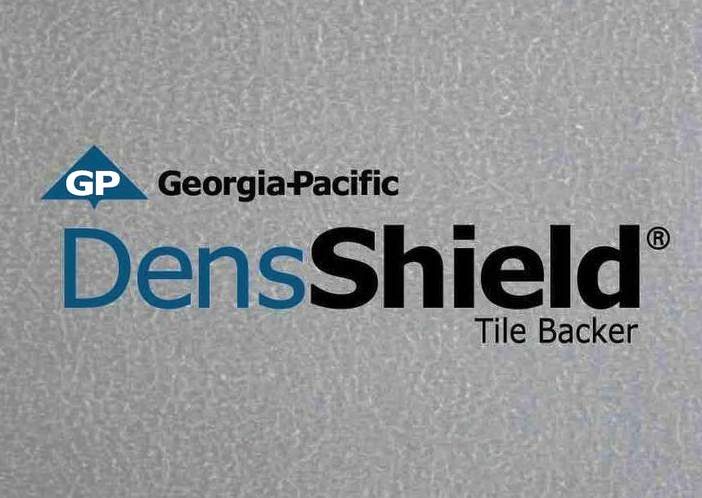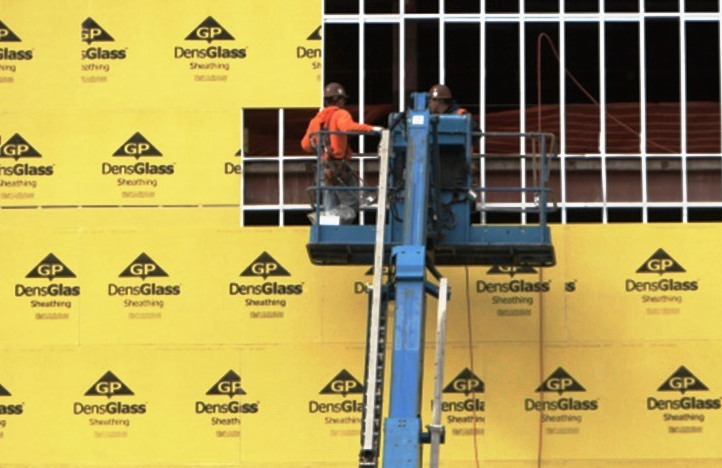DensShield Failure

Nothing is more annoying than a failed tile backing board. The entire project is destroyed when a tile backer board breaks, and you are typically left with no choice but to start over.
We’ll talk about DensShield, one of the most well-known tile backer boards, and its demise in today’s post. We’ll talk about the reasons behind this failure and preventative measures.
Let’s start by defining DensShield.
DensShield is a tile backer board made by George Pacific. Although DensShield can be used just like ordinary drywall, it is frequently employed in damp places like bathrooms and kitchens because of its exceptional moisture resistance.
This backer board makes the perfect tile underlayment. It is an improvement above standard cement board. Gypsum is used in its construction, and acrylic that resists moisture is applied on top. DensShield not only keeps moisture out of the space, but it also keeps mold from growing.
As a tile backer board, DensShield is unique in a number of ways. People adore utilizing it in their homes and offices because of this, especially in damp areas. It’s crucial to note how lightweight and simple to install DensShield is.
It’s evident from the above that DensShield offers a lot of advantages. Why then might it fail?
DensShield is an excellent tile backer board, although it is far from flawless. DensShield failure can result from a few different sources.
In the event that you are thinking about placing it on your house, you should educate yourself on these causes and discover preventative measures.
Key Factors That Lead to DensShield Failure (And How to Prevent It)
- 1. When installing the DensShield, leave gaps or seams exposed.
It is not acceptable for you to leave seams or holes when applying DensShield. That undermines the purpose for which DensShield was created in the first place. DensShield is a tile backer board that is resistant to moisture.
This feature attempts to prevent water from penetrating through the drywall, into the frame, and into other objects behind it.
Moisture can seep through areas created by seams and other holes. Consequently, DensShield would not even be useful. Considering that there won’t be any moisture shield.
When moisture seeps through DensShield’s gaps and seams, projects frequently fail as a result. Furthermore, do not be duped into believing that silicone or caulk may be used to seal these gaps. Due to their impermeable nature, these two will allow moisture to seep through and cause DensShield failure.
Recall that gypsum is the material of DensShield. It will get pasty and moist when it is exposed to a lot of water. And the likelihood of it collapsing is high.
Should you or a contractor fail to seal any gaps or seams on the DensShield, the project needs to be abandoned and restarted.
If any DensShield boards were installed, take them out and replace them properly, making sure there are no gaps or seams between. Accurate measurement taking is necessary to guarantee that the DensShield is installed correctly.
- 2. Putting DensShield in the tub or shower’s bottom
Bathrooms and other damp spaces are good uses for DensShield tile backer board. But that’s a surefire way to end up in the bottom of the tub or shower. DensShield will not work when used at the bottom of a shower or tub for the following two reasons.
DensShield is extremely light. As a result, neither the weight of a person nor a tub can be accommodated. Showers are in high-traffic locations, so the extra weight could push them out of shape.
Two, water is frequently exposed to the bottom of the shower or tub. That is where the drain is, after all. DensShield resists moisture. It isn’t watertight. This implies that it will become spongy when exposed to excessive moisture, at which point it will break.
The DensShield tile backer board shouldn’t be utilized at the base of a shower or bathtub for these two reasons. Professional contractors will tell you to avoid showers altogether when using DensShield.
In this case, replacing the DensShield with a cement board is the best way to prevent failure. The cement board is more resilient and won’t crumble or break over time when exposed to prolonged moisture exposure than the DensShield gypsum tile backer board.
- 3. Not Using a waterproofing agent to seal DensShield’s lower portion
One of the primary locations where DensShield is most prone to malfunction is the shower. After learning about the dangers of applying DensShield to the shower or bathtub’s floor, you could think about applying it to the walls. That’s acceptable given its characteristics.
However, you need to use a waterproofing solution to seal the bottom portion where the DensShield meets the floor or drain. Just to be clear, DensShield is not waterproof; it is water-resistant. The failure of DensShield stems from the idea that it is waterproof.
At the bottom edge, water is often present, which DensShield can absorb. Applying a waterproofing compound is therefore necessary to provide twofold protection against water damage.
- 4. Allowing Rain or Water to Enter DensShield While It’s Being Stored or Transported
DensShield does an amazing job of keeping moisture out after it is placed appropriately. When being transported or stored, DensShield must be kept as far away from water as feasible.
Avoid falling for marketing tricks that promise DensShield will remain flawless even after being submerged in water for several weeks. It is untrue.
Many say that DensShield behaves like ordinary sheetrock after being exposed to water during storage or transit.
The exposed areas frequently become spongy, which compromises the board’s structural integrity and renders it useless. It will fail automatically if you attempt to install it while it is in that state.
Make sure DensShield is sufficiently shielded from water exposure when storing or transporting it.
- 5. Failure to seal the screw penetrations
It is frequently insufficient to just seal DensShield’s bottom border. Additionally, the screw penetrations are weak spots.
Therefore, don’t forget to additionally waterproof these indentations. If not, moisture may seep into the screw holes and cause the DensShield to malfunction.
A correctly installed DensShield is essential to preventing failures.
In addition to storage and transit, the main cause of DensShield failures is poor installation. For example, if the DensShield has holes or the bottom isn’t sealed.
All of these are surefire ways to fail. In the event that you choose to install DensShield, be sure to adhere to the manufacturer’s recommendations. You can only be confident of a project’s success and longevity in this manner.
Georgia-Pacific rules state that precise measurements are necessary to guarantee a snug fit. After you have secured the ends of the backer board, caulk needs to be applied.
Please cover joints and seams with fiberglass tape. It’s not too difficult, and most people usually get it right the first time.
How Frequent Do DensShield Failures Occur?
The fact that there haven’t been many recorded product failures with DensShield tile backer board is a plus.
I looked into different web forums and found that there aren’t many complaints concerning DensShield malfunctions. And the installer’s carelessness is frequently the cause of the few reports. That is unrelated to the product’s quality.
Not to be overlooked is the fact that Georgia Pacific has never had to recall any of their tile backer boards because of malfunctions. That is a positive indication that this is a high-quality product, and as long as it is placed properly, there is no need for concern.
In order to avoid failure, you may always hire a competent contractor to install DensShield appropriately if you are unsure about your abilities to do it yourself.

